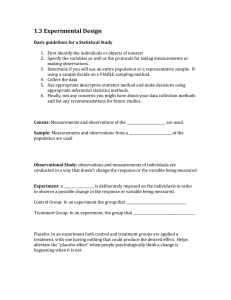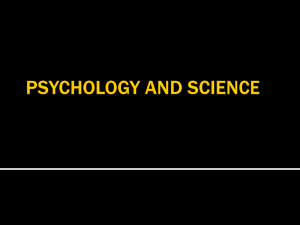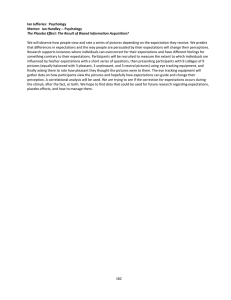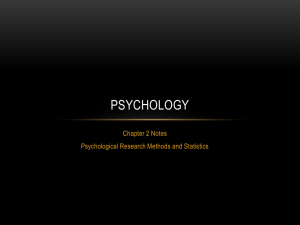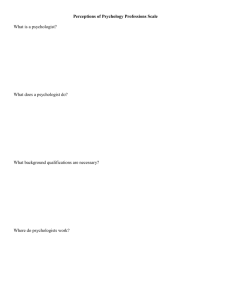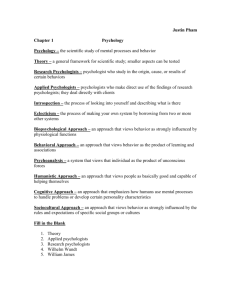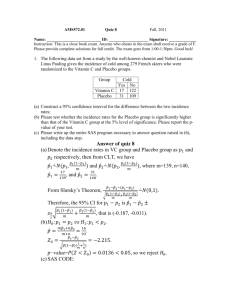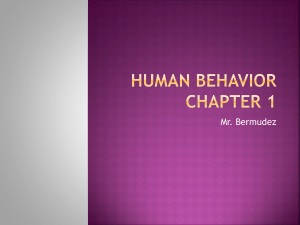Experimental Method in Psychology: Explaining Behavior
advertisement
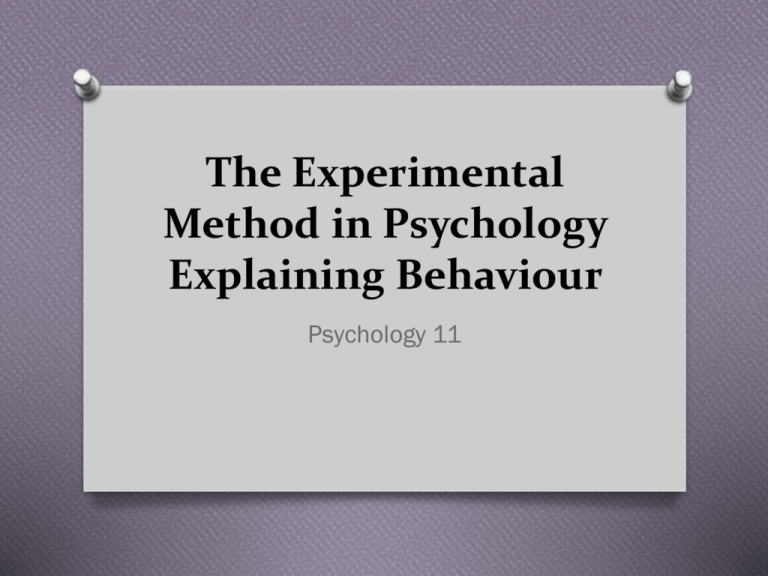
The Experimental Method in Psychology Explaining Behaviour Psychology 11 Scientific Method O In order to EXPLAIN behaviour, psychologists conduct carefully controlled experiments using the SCIENTIFIC METHOD. O We have already seen how psychologists gather information (observations, case studies, and surveys) in order to make predictions (correlations between variables). Information gathered is then put into carefully controlled scientific testing using the EXPERIMENTAL METHOD. Experimental Method 1. Experiments start with OBSERVATION. 2. Based on their observations, psychologists develop a SPECIFIC & TESTABLE HYPOTHESIS. O Example: drinking alcohol negatively affects memory. Experimental Method 3. Now, to see if this hypothesis is true, we need to MANIPULATE one variable. This variable is called the INDEPENDENT VARIABLE. We are interested in studying the EFFECT that this one variable has. O What would the independent variable be in the above example? We want to know if WHAT has an effect. 4. Yes, because we want to know if alcohol has an effect on thinking, it will be the INDEPENDENT VARIABLE (the variable that we manipulate). Therefore, we will expose one group of subjects to the INDEPENDENT VARIABLE (the alcohol). Experimental Method 5. The group who is exposed to the independent variable (sometimes referred to as the TREATMENT) is called the EXPERIMENTAL GROUP. Experimental Method 6. However, in order to be sure that it is the alcohol (and not something else) that had the effect, we need a comparison group. This group is called the CONTROL GROUP. The control group will be exposed to everything that the subjects in the experimental group are exposed to EXCEPT the independent variable (the alcohol). So, if the thinking abilities are different between the two groups then we KNOW that it must be due to the alcohol because the alcohol was the only difference between the two groups. Experimental Method 7. How do we ensure that the EXPERIMENTAL GROUP and the CONTROL GROUP are exactly the same in every way other than the independent variable (the alcohol)? Experimental Method 8. This is where a procedure called RANDOM ASSIGNMENT comes in. By assigning your subjects to groups randomly, the people in each group should equal each other on things like their age, their values, their opinions and on any other characteristics. The idea behind random assignment is that any person in your study could just have easily ended up in the experimental group as in the control group. Before the experiment begins, both groups are equally similar. So, you would need to use a random numbering system to assign subjects to groups. Experimental Method 9. In studies involving some kind of treatment (taking a pill for example), researchers often use a PLACEBO to make sure that both the experimental and control group are similar. In this example, a PLACEBO would involve giving the control groups something that looks and tastes like alcohol, but actually does not have any alcohol in it. This would allow subjects in both groups to go through the exact same experience during the experiment. O Can you think of potential problems in this study, if we did not use a PLACEBO? Experimental Method 10. Another procedure that is used in experiments to eliminate bias is called DOUBLE-BLIND PROCEDURE. This simply means that neither the researcher who is conducting the study nor the subjects in the study know who is in the experimental group and who is in the control group. Experimental Method 11. Once we have ensured that both the experimental group and control group are equal on all variables except the INDEPENDENT VARIBALE (the alcohol), then we begin our study. Each group of subjects will either receive alcohol (EXPERIMENTAL GROUP) or receive an inert drink that looks and tastes like alcohol, called a PLACEBO (CONTROL GROUP). Experimental Method 12. To see if alcohol had an effect on thinking, we would give both groups a memory test. This is called measuring to see if the INDEPENDENT VARIABLE (the alcohol) had an effect on the DEPENDENT VARIABLE. O What is the dependent variable? What are we measuring to see whether alcohol had an effect? Experimental Method 13. Yes, the memory test is the DEPENDENT VARIABLE. The memory test will tell us if our independent variable (the alcohol) had an effect on our subject’s thinking ability. 14. Now you will simply calculate the results of the memory test. If there is a difference between the memory scores of the subject’s in the experimental group and the memory of the subject’s in the control group, you can assume that it was due to the effect of the independent variable – the alcohol.

